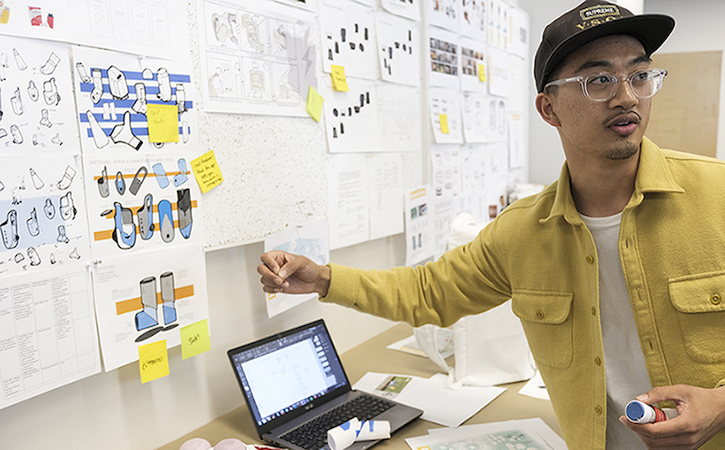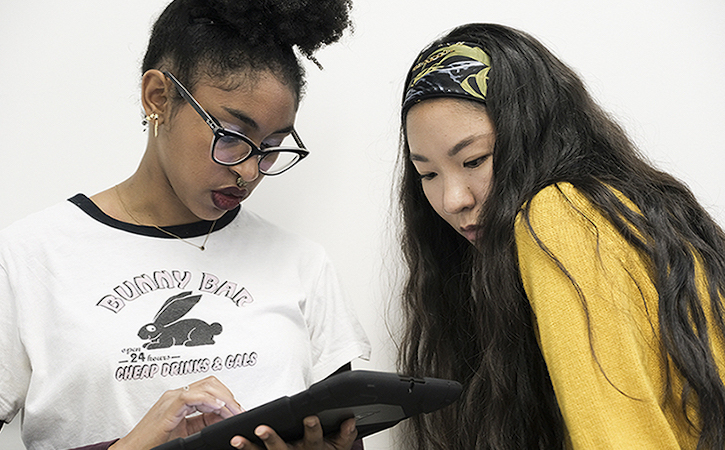Welcome to the School of Design at San Francisco State University! The School of Design serves a diverse body of students in the areas of Product Design and Visual Communication Design at both the undergraduate and graduate levels. Our curriculum emphasize design process as a means of problem solving, and our classes help students to build the technical, conceptual, critical and collaborative skills required in design professions.
Design Program Learning Outcomes (PLOs)
SKILLS AND TECHNOLOGY
For Industrial Design: Upon graduation, students will be able to:
-
Demonstrate skills with the tools, technologies, and software currently used in the design professions, including but not limited to: concept sketching and ideation, digital solid and surface modeling, prototype building, photorealistic rendering.
-
Recognize, select and use materials and manufacturing processes appropriate for the intended outcome
For Visual Communication Design: Upon graduation students will be able to:
-
Demonstrate proficiency in skills pertinent to design practice and its applications, including but not limited to: typography, composition, color, selection of media, sequence, motion, material exploration, creative coding, systems thinking, storytelling, experiential design, information architecture.
-
Use software and technology intended for design and its diverse applications.
PROCESS
(Both Programs) Upon graduation students will be able to:
-
Apply a structured design process to various situations of different scope and complexity, incorporating elements of design thinking and user-centered design. Design process stages might include: research, ideation, prototyping, testing and refinement, finalizing, implementation and evaluation.
CONTEXTUAL DESIGN
(Both Programs) Upon graduation students will be able to:
-
Recognize how design theories, principles, and practices have changed over time in response to shifting contexts.
-
Critically identify how design responds to, reflects and/or interacts with its broader contexts, including but not limited to: community, cultural, accessible, socioeconomic, technological, environmental, social, political.
-
Use their understanding of context to inform their own practice of responsible design.
RESEARCH
(Both Programs) Upon graduation students will be able to:
-
Analyze the design landscape and think critically about the users and stakeholders, feasibility, functionality, aesthetics, and broader social impact of the design.
-
Identify appropriate research and testing methods for the context, user needs, and outcome.
-
Apply findings throughout the design process.
VISUAL AND MATERIAL LITERACY
(Both Programs) Upon graduation students will be able to:
-
Demonstrate fluency in visual language and design vocabulary.
-
Demonstrate familiarity with critical theory and principles of perception, semiotics, rhetoric, and cultural context across relevant and evolving media.
-
Select and utilize materials and approaches based on their relevance to the context of use, user needs, and their environmental and cultural impact.
PROFESSIONAL COMMUNICATION
(Both Programs) Upon graduation students will be able to:
-
Document and present work according to professional expectations employing verbal, visual, and written means, including but not limited to: process books, creative briefs, technical documentation, critiques, summary documents, and portfolio.
INTERDISCIPLINARY COLLABORATION
(Both Programs) Upon graduation students will be able to:
-
Collaborate effectively with others both within and outside the field, including but not limited to: community organizations and industry partners.
SOCIAL JUSTICE AWARENESS
(Both Programs) Upon graduation students will be able to:
-
Identify and critically evaluate how design impacts and is impacted by systemic bias and discrimination.
-
Develop a socially just, ethical, respectful, responsible, and inclusive practice.
-
Demonstrate knowledge about traditionally excluded, non-Western, and emergent design practices.
ENVIRONMENTALLY SUSTAINABLE DESIGN
(Both Programs) Upon graduation, students will be able to
-
identify fundamental aspects of environmentally sustainable design practice, including but not limited to: sustainable materials and manufacturing processes, product life cycle, environmental impact.

